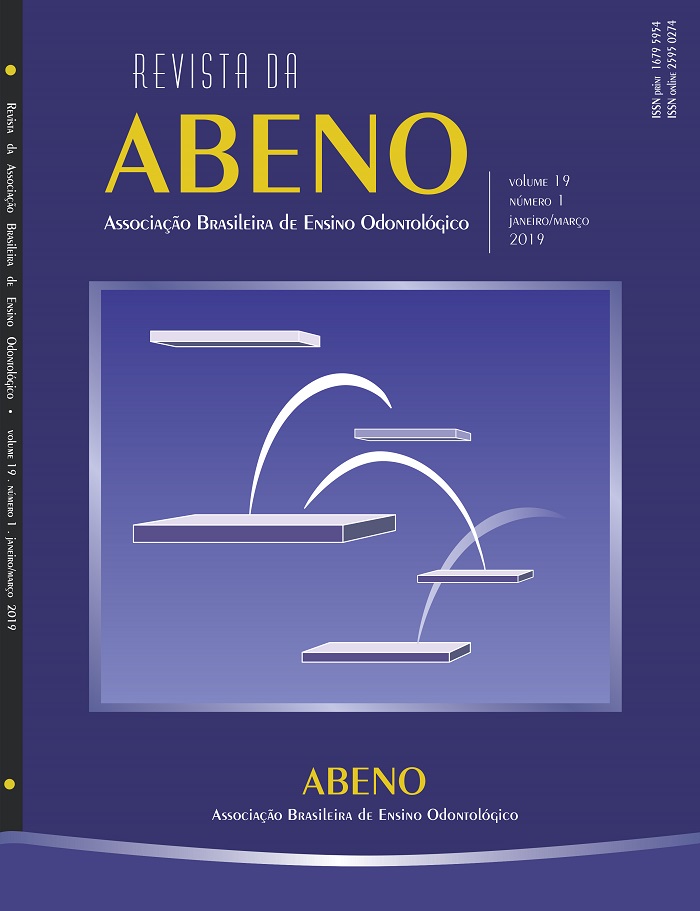Evolução da autoconfiança e segurança de estudantes após aprendizagem utilizando manequins em Periodontia
DOI:
https://doi.org/10.30979/rev.abeno.v19i1.783Palavras-chave:
Avaliação Educacional. Confiança. Manequins. Periodontia. Laboratórios Odontológicos.Resumo
A simulação no ensino em saúde é uma ferramenta que permite ao estudante uma aprendizagem em ambiente protegido e controlado, livre de intercorrências e com devolutiva instantânea da tarefa desempenhada. Na simulação, o docente pode intervir a qualquer momento, o que o auxilia na avaliação e instrução do estudante. O objetivo deste estudo foi avaliar a evolução da autoconfiança e segurança de estudantes após aprendizagem simulada utilizando manequim em um componente curricular de Periodontia e sua correlação com desempenho prático. Questionários utilizando escala visual analógica (EVA), escala numérica de 101 pontos (NRS-101) e escala verbal de 4 pontos (VRS-4) foram aplicados aos estudantes da Disciplina de Periodontia I da Universidade Federal do Paraná no primeiro semestre de 2018, em três momentos: 1) antes do início das atividades práticas; 2) após a fase laboratorial; e 3) após a fase clínica. Os dados obtidos foram comparados entre si pelo tempo de aplicação e correlacionados com a nota prática final. Os estudantes demonstraram maior autoconfiança e segurança no final do que no início do período (Friedman; p<0,05). Essa evolução foi notada principalmente entre a primeira e segunda aplicações dos questionários, ou seja, após a fase laboratorial simulada em manequim. Houve correlação entre autoconfiança e segurança aferidas pela NRS-101 e o desempenho prático (Spearman; r=0,3948 e r=0,3771, respectivamente; p<0,05). Observou-se aumento de autoconfiança e segurança dos estudantes após aprendizagem simulada em manequim, que se mostrou ligeiramente mais valiosa para evolução desses quesitos em comparação à experiência clínica.
Downloads
Referências
Dourado ASS, Giannella TR. Ensino baseado em simulação na formação continuada de médicos: análise das percepções de alunos e professores de um hospital do Rio de Janeiro. Rev Bras Educ Méd. 2014;38(4):460-9.
Mariani AW, Pêgo-Fernandes PM. Ensino médico: simulação e realidade virtual. Diagn Tratamento. 2012;17(2):47-8.
Iglesias AG, Pazin-Filho A. Emprego de simulações no ensino e na avaliação. Medicina (Ribeirão Preto). 2015;48(3):233-40.
Lee JS, Graham R, Bassiur JP, Lichtenthal RM. Evaluation of a local anesthesia simulation model with Dental students as novice clinicians. J Dent Educ. 2015; 79(12):1411-7.
Brand HS, Baart JA, Maas NE, Bachet I. Effect of a training model in local anesthesia teaching. J Dent Educ. 2010;74(8):876-9.
Michaelis Moderno Dicionário da Língua Portuguesa, 2015. [Acesso em 20 ago. 2018]. Disponível em: https://michaelis.uol.com.br/ moderno-portugues/busca/portugues-brasi leiro/
Costa RRO, Medeiros SM, Martins JCA, Menezes RMP. O uso da simulação no contexto da educação e formação em saúde e enfermagem: uma reflexão acadêmica. Espaç Saúde. 2015;16(1):59-65.
Volkweis MR, Oliveira AR, Faria FR, Wagner JCB, Gomes JP. Avaliação de uma técnica de exodontia em laboratório como instrumento de ensino - estudo piloto. Rev Cir Traumatol Buco-Maxilo-Fac. 2003; 3(1):31-6.
Tanalp J, Güven EP, Oktay I. Evaluation of dental students’ perception and self-confidence levels regarding endodontic treatment. Eur J Dent Educ. 2013;7(2):218-24.
Celik Y, Ceylantekin Y. The evaluation of simulation market in nursing education and the determination of learning style of students. Int J Health Sci. 2017;11(1):13-8.
Arigbede A, Denloye O, Dosumu O. Use of simulators in operative dental education: experience in southern Nigeria. Afr Health Sci. 2015;15(1):269-77.
Heym R, Krause S, Hennessen T, Pitchika V, Ern C, Hickel R. A new model for training in periodontal examinations using manikins. J Dent Educ. 2016;80(12):1422-9.
Varga CRR, Almeida VC, Germano CMR, Melo DG, Chachá SGF, Souto BGA, et al. Relato de experiência: o uso de simulações no processo de ensino-aprendizagem em Medicina. Rev Bras Educ Med. 2009; 33(2):291-7.
Prasad S, Bansal N. Predoctoral Dental students’ perceptions of dental implant training: effect of preclinical simulation and clinical experience. J Dent Educ. 2017;81(4): 395-403.
Hjermstad MJ, Fayers PM, Haugen DF, Caraceni A, Hanks GW, Loge JH, et al. Studies comparing numerical rating scales, verbal rating scales, and visual analogue scales for assessment of pain intensity in adults: a systematic literature review. J Pain Symptom Manage. 2011 41(6):1073-
Jensen MP, Karoly P, Braver S. The measurement of clinical pain intensity: a comparison of six methods. Pain. 1986 27(1):117-26.
Downloads
Publicado
Como Citar
Edição
Seção
Licença
Autores que publicam nesta revista concordam com os seguintes termos:
a) Autores mantém os direitos autorais e concedem à revista o direito de primeira publicação, com o trabalho simultaneamente licenciado sob a Licença Creative Commons Attribution que permite o compartilhamento do trabalho com reconhecimento da autoria e publicação inicial nesta revista.
b) Autores têm autorização para assumir contratos adicionais separadamente, para distribuição não-exclusiva da versão do trabalho publicada nesta revista (ex.: publicar em repositório institucional ou como capítulo de livro), com reconhecimento de autoria e publicação inicial nesta revista.
c) Autores têm permissão e são estimulados a publicar e distribuir seu trabalho online (ex.: em repositórios institucionais ou na sua página pessoal) a qualquer ponto antes ou durante o processo editorial, já que isso pode gerar alterações produtivas, bem como aumentar o impacto e a citação do trabalho publicado (Veja O Efeito do Acesso Livre).






